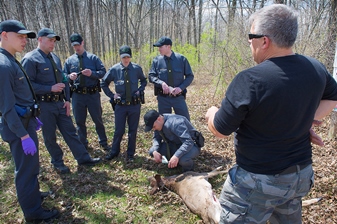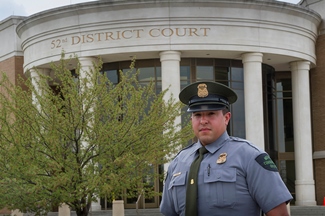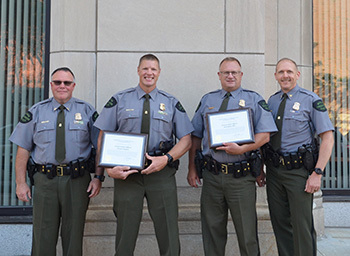Forensic training for conservation officers paying dividends
At 9 a.m. Nov. 18, conservation officer Richard Cardenas received a complaint that had been phoned in to the Michigan Department of Natural Resources’ Report All Poaching Line about a deer that had been shot.
The caller said she was awakened by a loud thud against her house at approximately 3 a.m. When she went outside to investigate, she discovered a deer lying near her house between a woodshed and the back porch. She then witnessed her neighbor come into her yard, claim the deer and drag it by the antlers to his property.
 After speaking to the witness, Cardenas went to the suspect’s residence next door, where he contacted the suspect and observed a bait pile in the backyard, with spotlights from the house pointed toward it.
After speaking to the witness, Cardenas went to the suspect’s residence next door, where he contacted the suspect and observed a bait pile in the backyard, with spotlights from the house pointed toward it.
Cardenas questioned the suspect about the deer in the back of his pickup truck, including about what time of day he shot the deer. The suspect first told Cardenas that he shot the deer at 6 a.m. After further questioning, the suspect changed his answer to say he didn’t know what the time was when he shot the deer.
Cardenas used his Traceable Thermometer, part of the forensic equipment issued to Michigan conservation officers for crime scene investigations, to take the internal thigh temperature of the deer. The thermometer gave a reading of 91.7 degrees Fahrenheit. Cardenas also took note of the outside air temperature and estimated the weight of the deer. Using this information, Cardenas consulted “A Guide to the Time of Death” – also part of his forensics kit. In addition to this equipment, conservation officers now have a new computer application to help them calculate time of death once all information regarding an incident is gathered. The information added up to the deer being dead approximately nine hours when Cardenas took the internal thigh temperature at 12:10 p.m.
Approaching the suspect again, Cardenas asked him what time he had shot the deer. The suspect replied 7 a.m. — again changing his story. Cardenas seized the deer and took it to a local processor and had it weighed. It weighed 191pounds. Using this weight, the officer was able to confirm the findings that the deer had been dead about nine hours when the internal thigh temperature was taken, putting the time of death at approximately 3 a.m.
In other words, the deer had been shot during the middle of the night, when hunting is prohibited. During firearm deer season, hunting only can occur from one-half hour before sunrise until one-half hour after sunset. On Nov. 18, hunters could legally hunt between 6:57 a.m. and 5:38 p.m. The suspect also was hunting using artificial lights and violated the safety zone regulations by hunting so close to his neighbor’s house. When the case proceeded to court, the suspect entered into a plea deal, saying the evidence against him was too compelling.
Cardenas is in his first year as conservation officer. He graduated from the DNR’s conservation officer training academy last June. While at the academy, he received a week of crime scene investigation and evidence collection training both in the classroom and in the field from David Stephens, executive in residence for Forensic Wildlife and Environmental Outreach at the School of Criminal Justice at Michigan State University and a forensics liaison to the DNR. Stephens is regarded as a leader in the field of wildlife forensic science, and the DNR Law Enforcement Division has a partnership with Stephens and MSU to develop online training courses for conservation officers in forensics.
 “With violators becoming savvier, it is important that we keep our officers current and up to date with the forensic tools available to them,” said DNR Law Enforcement Division Chief Gary Hagler. “This partnership with MSU and development of the online courses for our officers will make them among some of the most highly trained conservation officers in the nation, and will aid us tremendously in our investigations.”
“With violators becoming savvier, it is important that we keep our officers current and up to date with the forensic tools available to them,” said DNR Law Enforcement Division Chief Gary Hagler. “This partnership with MSU and development of the online courses for our officers will make them among some of the most highly trained conservation officers in the nation, and will aid us tremendously in our investigations.”
The online courses are created and administered by Stephens and Capt. Wade Hamilton of the DNR Law Enforcement Division. The first module, “Time of Death Estimation by Temperature Study of White-Tailed Deer,” provided training that is valuable to officers investigating poaching cases.
“We are fortunate to have a forensics expert like David Stephens at our disposal to help develop training that involves subjects that are relevant to conservation law enforcement,” Hagler added. “He is a valuable asset to our officers and our agency.”
The online modules will allow conservation officers across Michigan to access the training and complete it at a time that is convenient for them. The modules are from 20 minutes to an hour in length and include worksheets and quizzes to measure learning comprehension.
Hamilton said the next module that will be available to officers is one on the chain of custody for evidence collection.
When Stephens trained conservation officer recruits last spring for the DNR, each recruit received a 40-piece evidence collection and preservation kit. That training, along with the training module on time of death estimation in white-tailed deer, was invaluable to Officer Cardenas in the case he made in November.
“I am grateful for the training I obtained from David Stephens during the academy,” Officer Cardenas said, summing up his case. “Mr. Stephens’ training on the time of death was a key factor that helped in my investigation on this case.”
For more information about Michigan conservation officers, go to www.michigan.gov/conservationofficers.






